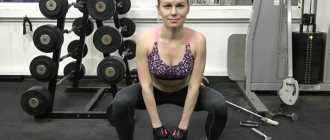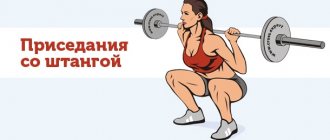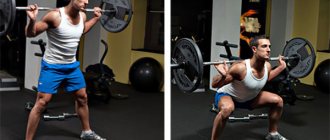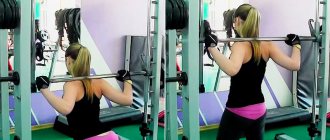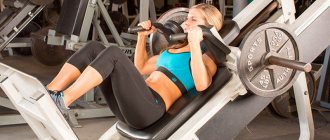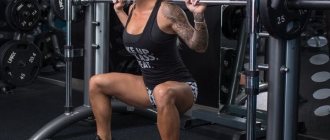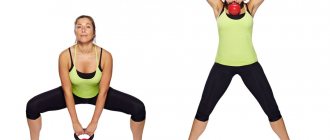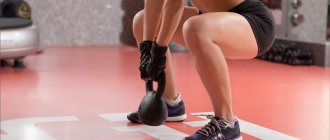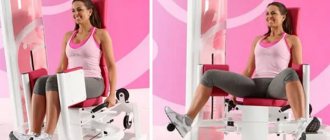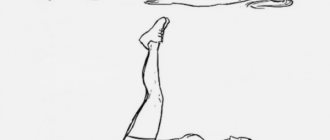Content:
- Why are squats so popular?
- Benefits of squats;
- Harm from squats;
- What muscles work when squats;
- General squat technique;
- Ways to squat at home:
- Plie
- Side step squats
- Jump Squats
- Wall Squats
- Gun
- Martin
- Scissors
- Ways to squat with a load:
- Squat with dumbbells
- Plie with kettlebell
- Squat with dumbbells on shoulders
- Single leg dumbbell squat
- Barbell Squat
- How to breathe correctly when squatting
How to squat correctly for men with a barbell?
- Exercises are performed to a parallel position with the floor. You can go lower. In the first case, the load on the knee joint is less.
- Deep squats increase the effectiveness of the exercise.
- When moving up, push off your heels from the floor surface. After straightening your legs, take your starting position.
- The downward movement is accompanied by inhalation, the upward movement by exhalation. You need to squat smoothly, without springing.
- Once you reach the top position, keep your legs slightly bent.
How to squat correctly for men with a barbell?
What is the reason for the popularity of squats?
It is not without reason that the legs are considered the support of our body. On average, we spend ten to twelve hours a day on our feet. Therefore, they need to be kept in good shape. But how? Many men believe that to pump up their body they need to go to the gym. But this is not entirely true. To build up a large mass, you undoubtedly need to lift iron, and it makes no sense to store it at home. Then you need a gym.
And for a sculpted and energetic body, doing exercises at home is enough. Squats are considered the king of such exercises, because they replace many others in terms of effectiveness. With the help of squats, you can lose weight, tighten your figure and keep yourself in good shape.
To create a sculpted body, especially the gluteal muscles and thighs, and increase leg endurance, it is recommended to lower and lift the body by bending the knees. Which leads to strengthening and building muscles. Also, if you do exercises every day, you can forget about pain at the end of the working day. The exercise is included for medical purposes; more precisely, it is prescribed as part of a cardio training program.
Squats, unlike other exercises, have the following advantages:
- Easy to perform, allowing you to do the actions at home and in the gym;
- Working with different types of muscles when changing your technique;
- You don't need to buy equipment to do squats.
Before starting training, read about the benefits and harms to understand the productivity of exercise on the body. I think every man is interested in knowing what these actions will bring to health.
How to squat correctly for a man to avoid damaging his knees?
If there are no injuries to the knee joint and the exercises are performed correctly, you don’t have to think about the risk of damaging your knees. However, you should still adhere to the following rules:
- The weight of the barbell is selected taking into account the exercises performed. Do not increase the load and pace to the maximum. Before starting exercises, take time to warm up and stretch your muscles.
- The exercises are performed smoothly, without jerking. Sudden movements are not allowed.
- For maximum load on the legs and muscles, the squat is performed to a right angle.
Benefits of Squats
The most effective actions on the body:
- Improves the circulatory system of the pelvis - this has a good effect on the body, and also helps in the treatment of prostatitis;
- Normalizes and gives elasticity to the skin;
- Straightens posture as the muscles of the back, buttocks and abs begin to work;
- Improves the functioning of the cardiovascular system;
- Good for digestive processes;
- Develops the kneecaps, calf muscles and hip joints;
- Affects the growth of body muscles;
- Destroys fats on the body.
Harm from squats
There is a lot of harm from squats if you do not follow the correct technique . For example, when your back is hunched, your shoulders are tilted forward, and the weight on your body is too heavy, you may encounter the following problems:
- Knee injuries (strained tendons);
- Discomfort in the kneecaps;
- Weakness in the joints;
- Complication in the spine.
If you have severe illnesses, then the decision to engage in sports activities, especially squatting movements, is only with the permission of the therapist. Otherwise, the consequences for the body are catastrophic, for example, for people with spinal problems and similar diseases. After what has been said, it will seem to you that playing sports is not easy - don’t despair , the main thing is to maintain discipline, like everywhere else.
Are there any contraindications and harm?
It is not advisable to do squats if a man has the following problems:
- chronic diseases of the joints and spine;
- hypertension, heart failure, ischemic heart disease;
- varicose veins of the legs;
- early period after injuries and operations.
There may be other restrictions on squat training. If you have chronic diseases or have doubts about the advisability of exercise, be sure to consult a specialist so as not to harm your health. [4]
There is a lot of information about the benefits of squats for men, but we should not forget about the possible negative consequences. The main danger: incorrect execution technique, which causes a person to experience excessive stress on the legs (knees).
This is fraught with sprains and ruptures of ligaments, and the appearance of chronic pain in the knee joints. If a man does not use high-quality sneakers with shock absorption and orthopedic insoles during exercise, his feet often hurt very much after squats.
What muscles work when squats
It is a well-known fact that representatives of the stronger sex, when playing sports, are more aggressive than representatives of the fair sex. This is manifested in the number of actions, more than a kilogram in weight (if sports equipment is used). On the one hand, it seems that home exercises without lifting weights will not bring the desired effect, but on the other hand, we use many muscles with just one squat, here are the most basic of them:
- gluteal
- soleus muscles
- quadriceps femoris
- adductor muscles of the thigh
General squat technique
A person engaged in physical training, and who has decided not to harm his health, must clearly reproduce the correct implementation of the following instructions:
- It should not fall very low, but to a distance when the thigh is parallel to the floor. Because deep approaches have a negative effect on the knee tendons.
- It is imperative to bend your knees at an angle of ninety degrees.
- A safe position is considered to be when your feet are at shoulder level.
- The feet should be fully on the surface, and be sure not to lift your torso off when squatting.
- When you rise from the floor, your knees do not protrude beyond your toes.
- While performing, you should only look forward.
- When performing, the back must be level, and the body is slightly tilted forward.
- When you lower, be sure to tense your gluteal muscles to improve the effect.
- All actions performed must be performed at a slow pace, avoid jerking.
- At the slightest sensation of pain, stop and rest for a few minutes.
- Delay from three to five seconds at the lowest point.
- Do the training in sets, thereby giving the muscles a break.
- Ten to fifteen reps, and three to four sets. If you add weight (dumbbells, barbell), then reduce the number of repetitions and approaches.
- You cannot increase the load immediately, only gradually. When a beginner has gained experience in the classic squat, only then use weights.
- You need to do exercises in the middle of training, if you have already warmed up, but not at the limit of your capabilities.
- If you start, do it every day.
- Inhale as you lower, exhale as you rise.
Benefits of Squats
As you probably already know, there are many benefits to doing squats. Squats can improve blood circulation throughout the body because they get the blood moving. The better your circulation, the more nutrients and oxygen will flow to your muscles and organs, which will help improve the appearance of your skin and make you feel better.
Perhaps the biggest benefit of squats that most people don't realize is that squats can significantly increase muscle size throughout your entire body. Squats are an intense exercise and release hormones that will help improve your upper and lower body. Additionally, there are many exercises that put a lot of stress on your body, but squats are a low energy output exercise, so they won't bother those with back problems or weak knees and ankles.
Squatting is a natural movement
Squatting is a natural human movement that most of us do almost every day without even realizing it. Every time you sit in a chair and then stand up, you are essentially doing a squat.
The squat is a movement that you are familiar with from an early age. Many physical activities require you to do things that you are not used to, which can cause unnecessary stress and harm your body. However, since you pretty much do some form of squatting almost every day, your body will become accustomed to the movement and won't hurt after you squat.
How to Stretch Your Lower and Upper Body for Squats
As you already know, in order to avoid injuring yourself during any type of exercise or workout, you need to stretch before you begin, and squats are no exception. When squatting, you want to be sure to stretch both your upper and lower body. Before performing squats, you need to stretch three main parts of your body: ankles, knees and hips, since these parts of the body will do most of the work.
If you try to do squats with unstretched ankles, you won't be able to squat as deep as you want, which means you'll limit the overall benefit of the exercise. Before you start squatting, be sure to stretch your ankles. Also, your knees are important in squats because they allow you to squat deeply. Try doing a few lunges forward, knee circles, then squat a couple of times. It is imperative to warm up and prepare your knees for work so as not to get injured. It is also important to warm up the whole body because during squats, not only the leg muscles are involved.
Finally, stretch your hips to ensure you don't round your back as you squat. Tight and unstretched hips can injure your spine.
Ways to squat at home
When doing squats at home, you should only use your own weight. Be more careful when using dumbbells and weights during exercise. Perhaps you don’t, then the option of using ordinary eggplants filled with water or sand is suitable. Follow the instructions for the classic method of squats, various options without a projectile and with a projectile. There are many types.
Even from the physical education bench, we are taught the standard version:
- Straight back, straight shoulders, gaze directed only forward. Be sure to tense your stomach and buttocks.
- Bending at the knees, tilt the body forward, moving the pelvis back.
- At a ninety-degree bend, hover for three to five seconds.
- Straighten your legs and raise your body without lifting your feet off the floor.
If you are tired, you can change the tension on your torso with the classic version, you need to change the position of your arms: cross them on your chest; put on the belt; parallel in front of you; cross into a lock; put on shoulders; throw it behind your head with your elbows apart.
Don't forget the importance of warming up. Before each workout, be sure to warm up, it makes your body more flexible. And this way you will achieve greater results from your activities. A big plus is the reduced risk of joint damage. And most importantly, do everything slowly!
After mastering the classic form, you can move on to actions where your own weight will be used:
Plie
| You need to get into a standing position and spread your legs as wide as possible. And spread your feet to the sides. Squat down as low as possible, bending your knees at right angles. Slowly rise to a standing position and straighten up. |
Side step squats
We get up and bring our feet together. We take a step to the side, moving the hip to the side. Bend your knees at a right angle. We return to the original position. Do the same task with the other side of the body. |
Jump Squat
| We get into the initial state, place our hands shoulder-width apart. We lower ourselves by bending our knees 90 degrees, while inhaling. And while exhaling, we jump from the lowest point. We squat when our feet touch the floor. When taking the first steps in mastering this technique, it is recommended to make only two or three approaches. |
Wall Squats
| Place your feet shoulder-width apart and lower your arms along your body. Standing, lean against the wall with the back of your head and back. Bend your knees and go down the wall, lowering your torso to take a sitting position. Maintain this state for a long time (as long as your body can withstand before it becomes painful). Return to a standing position. Do several repetitions in a row. |
Gun
We place our feet shoulder-width apart. We first transfer the entire body weight to one leg and lift the other. We stretch our arms forward and hold them. Look only forward, we work mentally, not visually. We begin to slowly bend the knee of the leg (on which we transferred all the weight), and come to a sitting position. Straighten the other leg as much as possible and keep it suspended. The torso should be slightly tilted forward and the pelvis should be pulled back. In a sitting position, tense your buttocks and thighs and hold this position for several seconds. Slowly return to the starting position, change legs, and begin performing again. |
Martin
| The exercise is completely similar to the “Pistol”. Except that you don't need to stay in a sitting position for a few seconds. And repeat squats until you feel pain. Then we change legs and do it again. |
Scissors
| In a straight standing position, put your first leg back. Bend your knees at an angle of 90. Go down on one knee. By slightly touching the floor, return to the initial state. Do the number of repetitions with the first leg until it starts to hurt. Then we change to the second one and begin action again. |
Correct squat technique for men
To achieve good results, you need to know how to squat correctly for men. The squatting technique is quite simple; we have been familiar with it since preschool age, so no problems should arise. In this case, the following rules must be taken into account:
- You need to keep your back straight. Don't round it and try not to slouch.
- To support your spinal column, tighten your abdominal muscles. Feet should be kept shoulder width apart.
- Your heels should be flat on the floor. Do not lift your feet off the floor. Exceptions may be certain exercises where, when straightening, you need to rise on your toes.
- The bottom point of a squat involves the formation of a right angle between the thigh and shin. Your knees should be parallel to your feet. If they deviate inward or outward, the squat technique for men will be incorrect.
When squats, you need to breathe correctly. You need to lower as you exhale, rise as you inhale. Breathe deeply, in a natural rhythm, do not hold your breath.
Ways to squat with a load
The methods of exercise without the use of heavy artillery were described above. Below is a description of exercises where dumbbells and weights are used. But remember about safety precautions and compliance with the accuracy of the exercise technology. This way you will avoid medical interventions, maintain and improve your health.
Squats with dumbbells
| We take dumbbells in both hands and place them along the body. We take a standard pose (straight back, straightened shoulders, etc.). While squatting, we inhale air, the kneecaps should be bent at an angle of 90. We hold in a sitting position for three or five seconds. We return to the starting position by straightening our legs, do not forget to exhale when lifting. |
Plie with kettlebells or dumbbells
| A plie with one kettlebell is performed almost the same as without a kettlebell. Just adding a couple of actions to the exercise. In the created stance (Plie), we take the weight with both hands. We place our hands between our knees and bend our elbows slightly. When straightening your legs, pull the weights to your chest if possible. |
Squat with dumbbells on shoulders
| In each hand there is a dumbbell (you take kilograms of equipment from small, then everything depends on the pain, look and gradually the load increases), bend your elbows, thereby bringing the equipment closer to your shoulder. Let's start with the classic exercise. When rising from a seated position, it is important to keep the dumbbells at shoulder level. And to achieve greater efficiency, lift the projectiles upward when straightening. |
Single leg dumbbell squats
| You'll need another chair here. We take a small weight in each hand and place it lengthwise to the body. Straight stance, we take one leg back and throw it back onto the chair. We do the exercise on the supporting leg, but we must remember that the knee of the second leg, which is thrown back onto the chair, does not touch the floor during the squatting movement. |
Squats
| The most effective way (without the interaction of chemicals) to combat impotence and increase male strength, we can safely say that this is squats with a barbell. To do this, you must follow the correct execution of the exercise technique. Place the barbell on the rack in such a way that it is easier to grab it rather than stretch it. Place it on half of your lower trapezius and grasp the bar with your hands shoulder-width apart. We take a deep breath, then slowly lower ourselves lower, bending at the knees. We move our body a little forward, but remember to keep our back straight. We fixate in a low position for three seconds. Exhale rise. |
30 Day Squat Program for Men: Description
To keep the body fit and slim, a special squat program has been developed. It is designed for 30 days of regular classes. All exercises are performed under normal conditions; no special sports equipment is required. By performing squats according to the method described below, you can get rid of excess weight and fat deposits.
How to do it?
You can only count on results if you follow the technique of performing a set of exercises. In addition, it does not cause difficulties even for beginner athletes.
Rules for performing squats:
- in the starting position, the back remains flat and does not round
- the abdominal muscles tighten, this helps support the spinal column
- feet in the starting position are shoulder-width apart
- your heels should be flat on the floor
- the feet do not come off the floor surface if, during the exercise, there is no straightening with lifting on the toes
- At the bottom point when performing a squat, a right angle should be formed between the thigh and shin, the knees should be parallel to the feet (if the knees deviate inward or outward, the exercise is considered incorrectly performed)
Benefits of the 30 Day Squat Program include:
- training the gluteal muscles, quadriceps and hip adductors
- pumping the muscles of the whole body (oblique and rectus abdominis muscles, which form beautiful relief “squares”)
- there is an enhanced effect on all groups of muscle fibers of the lower extremities
- coordination and functioning of joints improves
If it is necessary to increase the load, it is recommended to use weights and sports equipment.
The 30-day squat program is not monotonous. There are various options for performing a set of exercises, allowing you to individually select the optimal load. You can perform squats with a barbell or dumbbells. But these options are not for beginners. It is better for them to start with classical equipment, and to enhance the effect, gradually add sports equipment.
If it is necessary to increase the load, it is recommended to use weights and sports equipment.
Modification of the classic version of the set of exercises:
- Single leg squats. This exercise is available for advanced levels. The difficulty lies in maintaining balance. To make the exercise easier, you can hold onto a support. The advantage of this exercise is that it uses smaller muscles. During classic squats, they are not involved in the work.
- Performing squats using weights. The role of cargo can be performed by any available items, for example, bottles filled with sand and water. If the complex is performed in the gym, then dumbbells, a barbell, and a barbell are used. The small weight of the weight increases gradually.
- Plie with legs wide apart in the starting position is performed with great depth. The sumo exercise is similar to a plie, with the only difference being that the legs should not be spread very wide, and the knees and toes should be pointing outward.
- Performing shallow squats to work other muscle groups.
- Wall squats. The exercise is performed in such a way that the back remains pressed against the wall. Squats are performed with your back sliding along the wall. Feet in the starting position shoulder width apart. This exercise helps to unload the back muscles and reduce the load on the spine. Squats with a jump while exhaling instead of straightening. This exercise significantly increases the load.
- With taking steps to the side. Legs in starting position together. A step to the side is performed, and then inhalation and squatting. As you exhale, return to the starting position. Repeat the exercise on the other side.
30-day squat program for men: description
Additional load during squats can be provided by changing the position of the hands.
- Having your arms outstretched in front of you helps you maintain your balance.
- Hands on the belt provide a static load on the muscles that stabilize the body position.
- If you cross your arms over your shoulders, then those muscles that are responsible for stabilization are trained. If your hands are behind your head, then the load falls on the chest muscles, and the respiratory and cardiovascular systems are trained.
For training to be effective, you need to exercise intensively and regularly. And if you haven’t worked out before, but decided to try a set of exercises, then first determine your capabilities. During your first classes, do not perform the entire complex or 100 repetitions at once. Start with a load that will invigorate your body and keep you full of strength.
The table shows age norms and the number of squats for each level.
| Age (years) | Up to 30 | 30-39 | Over 39 |
| First level | Number of squats | ||
| Great | 49 | 41 | 31 |
| Very tall | 44-49 | 36-41 | 26-31 |
| High | 36-43 | 28-35 | 20-25 |
| Average | 26-35 | 19-27 | 15-19 |
| Short | 25 | 18 | 14 |
- The number of repetitions and repetitions is adjusted depending on the level of physical fitness. And if it is low, then in the first training there should be no more than 6-9 repetitions. At an average level, you can perform 12-17 repetitions.
- If you have a high level of fitness, then there can be 20 repetitions. Between approaches you need to take a break of 1 minute.
- You can start performing a set of exercises according to the 30-day program only after the number of squats performed reaches 50.
30-day training program for entry level:
| Training day | Number of squats |
| 1 | 50 |
| 2 | 55 |
| 3 | 60 |
| 4 | Day of rest |
| 5 | 70 |
| 6 | 75 |
| 7 | 80 |
| 8 | Day of rest |
| 9 | 100 |
| 10 | 105 |
| 11 | 110 |
| 12 | Day of rest |
| 13 | 130 |
| 14 | 135 |
| 15 | 140 |
| 16 | Day of rest |
| 17 | 150 |
| 18 | 155 |
| 19 | 160 |
| 20 | Day of rest |
| 21 | 180 |
| 22 | 185 |
| 23 | 190 |
| 24 | Day of rest |
| 25 | 220 |
| 26 | 225 |
| 27 | 230 |
| 28 | Day of rest |
| 29 | 240 |
| 30 | 250 |
- Don't be scared by these numbers. At the beginning of training, it is allowed to perform squats in several approaches. Gradually, provided you practice regularly, the achieved result will only motivate you to increase the number of repetitions.
- According to reviews, the result of training will be noticeable after passing the equator of the program, namely on the 15th day. In order for different muscle groups to be involved in the work, exercises must be performed in various modifications.
How to breathe correctly when squatting
During any activity, you must remember how to breathe effectively and not disrupt your breathing rhythm. Oxygen is needed by the body to maintain endurance. Directly affects the health of the body, organizes access of oxygen to the blood. This means it makes the lesson more effective. A large flow of oxygen allows you to speed up the burning of fat deposits, improve the recovery of muscle strength, and fatigue goes away faster. The importance of breathing comes first.
When performing the exercise, you need to inhale at a time when the muscles are in a relaxed state. We exhale when we are tense to the maximum. For example, actions performed with a barbell, inhalation occurs when bending, and exhalation occurs when lifting.
It is imperative that the breathing be deep, but at the same time comfortable. Anything uncomfortable prevents the body from achieving great results. When inhalation occurs, the stomach should inflate. Yes, perhaps you find this action less convenient than multiple inhalation actions. But it is precisely in this rhythm of breathing that the body is ensured to receive the maximum amount of oxygen without wasting energy.
The big result depends on how you breathe (through the nose or mouth). It is imperative to inhale through the nasal passages, since as the air passes through it heats up, it becomes moist and clean from any infection. But we exhale through the mouth so that the air comes out faster. In this way, we ensure ourselves long endurance during training, since an erratic rhythm leads to a large loss of energy.
How do squats affect potency?
Correctly performed exercise has the following positive effects:
- works on the pelvic area;
- strengthens and trains tendons and muscles;
- improves posture;
- stimulates the functioning of organs in the lower abdomen;
- creates tension in the legs, back, abs, buttocks;
- provides a light and natural massage of the prostate gland.
Squatting stimulates the PC muscle, which is responsible for erections. Its development allows you to prolong sexual intercourse and reduce the risk of developing peristalsis diseases.
Potency directly depends on blood supply. Squats help prevent stagnation of processes in the cavernous and spongy bodies, penile bulbs adjacent to the genitourinary diaphragm. They affect blood flow to various parts of the genital organ, which allows the phallus to swell and increase in size during coitus.
How do squats affect potency?
